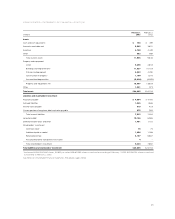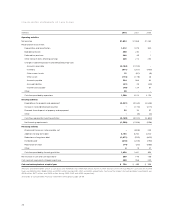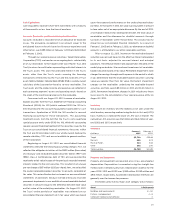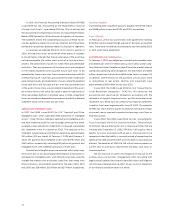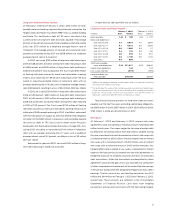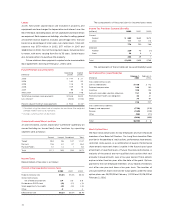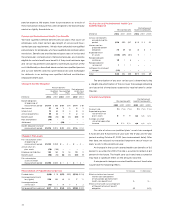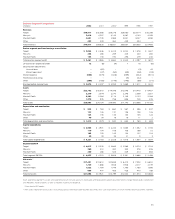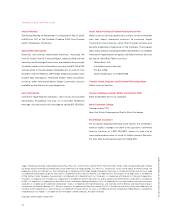Target 2002 Annual Report Download - page 36
Download and view the complete annual report
Please find page 36 of the 2002 Target annual report below. You can navigate through the pages in the report by either clicking on the pages listed below, or by using the keyword search tool below to find specific information within the annual report.
pension expense. We expect lower future expenses as a result of
these transactions because they were designed to be economically
neutral or slightly favorable to us.
Pension and Postretirement Health Care Benefits
We have qualified defined benefit pension plans that cover all
employees who meet certain age, length of service and hours
worked per year requirements. We also have unfunded non-qualified
pension plans for employees who have qualified plan compensation
restrictions. Benefits are provided based upon years of service and
the employee’s compensation. Retired employees also become
eligible for certain health care benefits if they meet minimum age
and service requirements and agree to contribute a portion of the
cost. Additionally, as described above, certain non-qualified pension
and survivor benefits owed to current executives were exchanged
for deferrals in an existing non-qualified defined contribution
employee benefit plan.
Change in Benefit Obligation
Pension Benefits Postretirement
Qualified Non-qualified Health Care
Plans Plans Benefits
(millions) 2002 2001 2002 2001 2002 2001
Benefit obligation
at beginning of
measurement period
$1,014 $ 863 $ 53 $ 54 $114 $ 99
Service cost
57 48 1222
Interest cost
72 65 3488
Actuarial (gain)/loss
59 88 –9214
Benefits paid
(50) (50) (5) (16) (10) (9)
Plan amendments
(74) –––––
Settlement
––(29) –––
Benefit obligation at end of
measurement period
$1,078 $1,014 $ 23 $ 53 $116 $114
Change in Plan Assets
Fair value of plan assets
at beginning of
measurement period
$1,033 $1,020 $ – $ – $ – $ –
Actual return on
plan assets
(79) (100) ––––
Employer contribution
154 163 516 10 9
Benefits paid
(50) (50) (5) (16) (10) (9)
Fair value of plan
assets at end of
measurement period
$1,058 $1,033 $ – $ – $ – $ –
Reconciliation of Prepaid/(Accrued) Cost
Funded status
$ (20) $ 19 $(23) $(53) $(116) $(114)
Unrecognized actuarial
loss/(gain)
530 292 621 711
Unrecognized prior
service cost
(73) 13712
Net prepaid/(accrued) cost
$437 $312 $(14) $(25) $(108) $(101)
Net Pension and Postretirement Health Care
Benefits Expense
Postretirement
Pension Benefits HealthCare Benefits
(millions) 2002 2001 2000 2002 2001 2000
Service cost benefits
earned during the
period $58 $50 $47 $ 2 $ 2 $2
Interest cost on
projected benefit
obligation 75 69 63 88 7
Expected return
on assets (108) (89) (81) 1– –
Recognized gains
and losses 10 1 8 –– –
Recognized prior
service cost 11 1 –– –
Settlement/curtailment
charges (12) – – –– –
Total $24 $32 $38 $11 $10 $9
The amortization of any prior service cost is determined using
a straight-line amortization of the cost over the average remaining
service period of employees expected to receive benefits under
the plan.
Actuarial Assumptions
Postretirement
Pension Benefits HealthCare Benefits
2002 2001 2000 2002 2001 2000
Discount rate 7
%
71⁄4
%
73⁄4
%
7
%
71⁄4
%
73⁄4
%
Expected long-term
rate of return on
plans’ assets 99 9 n/a n/a n/a
Average assumed
rate of compensation
increase 441⁄443⁄4n/a n/a n/a
Our rate of return on qualified plans’ assets has averaged
3.7 percent and 9.3 percent per year over the 5-year and 10-year
periods ending October 31, 2002 (our measurement date). After
that date, we reduced our expected long-term rate of return on
plans’ assets to 81
⁄
2percent per year.
An increase in the cost of covered health care benefits of 6.0
percent is assumed for 2003. The rate is assumed to remain at 6.0
percent in the future. The health care cost trend rate assumption
may have a significant effect on the amounts reported.
A one percent change in assumed health care cost trend rates
would have the following effects:
1% Increase 1% Decrease
Effect on total of service and
interest cost components
of net periodic postretirement
health care benefit cost $– $ –
Effect on the health care component
of the postretirement benefit
obligation $5 $(5)
34



